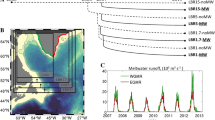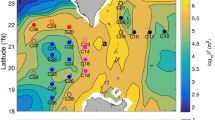Abstract
The ocean’s global overturning circulation regulates the transport and storage of heat, carbon and nutrients. Upwelling across the Southern Ocean’s Antarctic Circumpolar Current and into the mixed layer, coupled to water mass modification by surface buoyancy forcing, has been highlighted as a key process in the closure of the overturning circulation1,2. Here, using twelve high-resolution hydrographic sections in southern Drake Passage, collected with autonomous ocean gliders, we show that Circumpolar Deep Water originating from the North Atlantic, known as Lower Circumpolar Deep Water, intersects sloping topography in narrow and strong boundary currents. Observations of strong lateral buoyancy gradients, enhanced bottom turbulence, thick bottom mixed layers and modified water masses are consistent with growing evidence that topographically generated submesoscale flows over continental slopes enhance near-bottom mixing3,4, and that cross-density upwelling occurs preferentially over sloping topography5,6. Interactions between narrow frontal currents and topography occur elsewhere along the path of the Antarctic Circumpolar Current, which leads us to propose that such interactions contribute significantly to the closure of the overturning in the Southern Ocean.
This is a preview of subscription content, access via your institution
Access options
Access Nature and 54 other Nature Portfolio journals
Get Nature+, our best-value online-access subscription
$29.99 / 30 days
cancel any time
Subscribe to this journal
Receive 12 print issues and online access
$259.00 per year
only $21.58 per issue
Buy this article
- Purchase on Springer Link
- Instant access to full article PDF
Prices may be subject to local taxes which are calculated during checkout




Similar content being viewed by others
References
Marshall, J. & Radko, T. Residual-mean solutions for the Antarctic Circumpolar Current and its associated overturning circulation. J. Phys. Oceanogr. 33, 2341–2354 (2003).
Marshall, J. & Speer, K. Closure of the meridional overturning circulation through Southern Ocean upwelling. Nat. Geosci. 5, 171–180 (2012).
Molemaker, M. J., McWilliams, J. C. & Dewar, W. K. Submesoscale instability and generation of mesoscale anticyclones near a separation of the California Undercurrent. J. Phys. Oceanogr. 45, 613–629 (2015).
Gula, J., Molemaker, J. & McWilliams, J. C. Topographic generation of submesoscale centrifugal instability and energy dissipation. Nat. Commun. 7, 12811 (2016).
De Lavergne, C., Madec, G., Le Sommer, J., Nurser, A. G. & Naveira Garabato, A. C. On the consumption of Antarctic Bottom Water in the abyssal ocean. J. Phys. Oceanogr. 46, 635–661 (2016).
Ferrari, R., Mashayek, A., McDougall, T. J., Nikurashin, M. & Campin, J.-M. Turning ocean mixing upside down. J. Phys. Oceanogr. 46, 2239–2261 (2016).
Speer, K., Rintoul, S. R. & Sloyan, B. The diabatic Deacon cell. J. Phys. Oceanogr. 30, 3212–3222 (2000).
Sloyan, B. & Rintoul, S. The Southern Ocean limb of the global deep overturning circulation. J. Phys. Oceanogr. 31, 143–173 (2001).
Munk, W. H. Abyssal recipes. Deep-Sea Res. 13, 707–730 (1966).
Wolfe, C. L. & Cessi, P. The adiabatic pole-to-pole overturning circulation. J. Phys. Oceanogr. 41, 1795–1810 (2011).
Naveira Garabato, A. C., Williams, A. P. & Bacon, S. The three-dimensional overturning circulation of the Southern Ocean during the WOCE era. Prog. Oceanogr. 120, 41–78 (2014).
Talley, L. D. Closure of the global overturning circulation through the Indian, Pacific, and Southern Oceans: schematics and transports. Oceanography 26, 80–97 (2013).
Ferrari, R. et al. Antarctic sea ice control on ocean circulation in present and glacial climates. Proc. Natl Acad. Sci. USA 111, 8753–8758 (2014).
Orsi, A. H. & Whitworth III, T. Hydrographic Atlas of the World Ocean Circulation Experiment (WOCE): Volume 1: Southern Ocean (WOCE International Project Office, 2005).
Naveira Garabato, A. C., Stevens, D. P., Watson, A. J. & Roether, W. Short-circuiting of the overturning circulation in the Antarctic Circumoplar Current. Nature 447, 194–197 (2007).
Silvester, J. M., Lenn, Y.-D., Polton, J. A., Rippeth, T. P. & Maqueda, M. M. Observations of a diapycnal shortcut to adiabatic upwelling of Antarctic Circumpolar Deep Water. Geophys. Res. Lett. 41, 7950–7956 (2014).
Orsi, A. H., Smethie, W. M. & Bullister, J. L. On the total input of Antarctic waters to the deep ocean: a preliminary estimate from chlorofluorocarbon measurements. J. Geophys. Res. 107, 31-1–31-14 (2002).
Armi, L. Some evidence for boundary mixing in the deep ocean. J. Geophys. Res. 83, 1971–1979 (1978).
Polzin, K. L., Garabato, A., Abrahamsen, E. P., Jullion, L. & Meredith, M. P. Boundary mixing in Orkney passage outflow. J. Geophys. Res. 119, 8627–8645 (2014).
Orsi, A. H., Whitworth III, T. & Nowlin, W. D. On the meridional extent and fronts of the Antarctic Circumpolar Current. Deep-Sea Res. 42, 641–673 (1995).
Gill, A. E. Circulation and bottom water production in the Weddell Sea. Deep-Sea Res. 20, 111–140 (1973).
Thomas, L. N., Taylor, J. R., Ferrari, R. & Joyce, T. M. Symmetric instability in the Gulf Stream. Deep-Sea Res. II 91, 96–110 (2013).
Lozovatsky, I., Fernando, H. & Shapovalov, S. Deep-ocean mixing on the basin scale: inference from North Atlantic transects. Deep-Sea Res. I 55, 1075–1089 (2008).
Todd, R. E. High-frequency internal waves and thick bottom mixed layers observed by gliders in the Gulf Stream. Geophys. Res. Lett. 44, 6316–6325 (2017).
Phillips, O. M., Shyu, J.-H. & Salmun, H. An experiment on boundary mixing: mean circulation and transport rates. J. Fluid Mech. 173, 473–499 (1986).
Garrett, C., MacCready, P. & Rhines, P. Boundary mixing and arrested Ekman layers: rotating stratified flow near a sloping boundary. Annu. Rev. Fluid Mech. 25, 291–323 (1993).
Flexas, M. M., Schodlok, M., Padman, L., Menemenlis, D. & Orsi, A. Role of tides on the formation of the Antarctic Slope Front at the Weddell–Scotia Confluence. J. Geophys. Res. 120, 3658–3680 (2015).
Rosso, I., Hogg, A. M., Kiss, A. E. & Gayen, B. Topographic influence on submesoscale dynamics in the Southern Ocean. Geophys. Res. Lett. 42, 1139–1147 (2015).
Thompson, A. F., Stewart, A. L. & Bischoff, T. A multi-basin residual-mean model for the global overturning circulation. J. Phys. Oceanogr. 46, 2583–2604 (2016).
Tamsitt, V. et al. Spiraling pathways of global deep waters to the surface of the Southern Ocean. Nat. Commun. 8, 172 (2017).
Thorpe, S. A. The Turbulent Ocean (Cambridge Univ. Press, 2005).
Acknowledgements
X.R., A.F.T. and M.M.F. received support from NSF grant OPP-1246460. J.S. received support from NSF grant OPP-1246160. A.F.T. also received support from the David and Lucille Packard Foundation.
Author information
Authors and Affiliations
Contributions
A.F.T. and J.S. conceived and designed the field programme; X.R., A.F.T. and J.S. collected the data; X.R., A.F.T. and M.M.F. analysed the data; X.R., A.F.T., M.M.F. and J.S. co-wrote the paper.
Corresponding author
Ethics declarations
Competing interests
The authors declare no competing financial interests.
Supplementary information
Supplementary Information
Supplementary Information (PDF 2568 kb)
Rights and permissions
About this article
Cite this article
Ruan, X., Thompson, A., Flexas, M. et al. Contribution of topographically generated submesoscale turbulence to Southern Ocean overturning. Nature Geosci 10, 840–845 (2017). https://doi.org/10.1038/ngeo3053
Received:
Accepted:
Published:
Issue Date:
DOI: https://doi.org/10.1038/ngeo3053
This article is cited by
-
High resolution seafloor thermometry for internal wave and upwelling monitoring using Distributed Acoustic Sensing
Scientific Reports (2023)
-
Multi-time scale control of Southern Ocean diapycnal mixing over Atlantic tracer budgets
Climate Dynamics (2023)
-
Observations and modeling of symmetric instability in the ocean interior in the Northwestern Equatorial Pacific
Communications Earth & Environment (2022)
-
The Kuroshio flowing over seamounts and associated submesoscale flows drive 100-km-wide 100-1000-fold enhancement of turbulence
Communications Earth & Environment (2021)
-
Field-observation for an anticyclonic mesoscale eddy consisted of twelve gliders and sixty-two expendable probes in the northern South China Sea during summer 2017
Science China Earth Sciences (2019)



